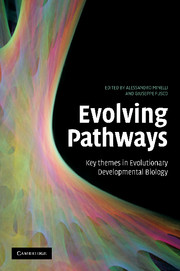Book contents
- Frontmatter
- Contents
- Contributors
- Preface
- Introduction: Pathways of change
- Part I Thinking about evolution by taking development on board
- Part II Evo-devo: methods and materials
- Part III Evolving diversity
- 12 Unravelling body plan and axial evolution in the Bilateria with molecular phylogenetic markers
- 13 Are transposition events at the origin of the bilaterian Hox complexes?
- 14 Many roads lead to Rome: different ways to construct a nematode
- 15 Basal euarthropod development: a fossil-based perspective
- 16 Developmental transitions during the evolution of plant form
- Part IV Evolving body features
- Index
- References
14 - Many roads lead to Rome: different ways to construct a nematode
Published online by Cambridge University Press: 08 August 2009
- Frontmatter
- Contents
- Contributors
- Preface
- Introduction: Pathways of change
- Part I Thinking about evolution by taking development on board
- Part II Evo-devo: methods and materials
- Part III Evolving diversity
- 12 Unravelling body plan and axial evolution in the Bilateria with molecular phylogenetic markers
- 13 Are transposition events at the origin of the bilaterian Hox complexes?
- 14 Many roads lead to Rome: different ways to construct a nematode
- 15 Basal euarthropod development: a fossil-based perspective
- 16 Developmental transitions during the evolution of plant form
- Part IV Evolving body features
- Index
- References
Summary
It has been well established that considerable differences exist in the developmental pattern among animal taxa, for instance with respect to how blastomeres perform their early cleavages, how they acquire different fates or how symmetry is formed (Gilbert and Raunio 1997). Even among relatively closely related species, for instance within sea urchins or tunicates, impressive differences can be found in the pattern of development (Jeffery et al. 1999, Raff 1999).
Nematodes appear to be excellent candidates for a comparative study of early embryogenesis (Schierenberg 2005a). The phylum Nematoda is very old, its origin dating back to the Cambrian (Douzery et al. 2004), and has many different species (estimates range from tens of thousands to several millions); eggs can develop outside the mother from the first cleavage onward, they are transparent (although to a variable degree), the freshly hatched juveniles appear to have essentially invariant species-specific cell numbers of around 600 cells (for those species tested so far), many strains can be cultured in the laboratory on simple agar plates, and, last but not least, one of them, Caenorhabditis elegans, has become one of the best-studied model systems.
In this chapter, selected aspects of the early embryogenesis of five representatives from different branches of the phylogenetic tree are compared with C. elegans and the impact of the observed differences for evolutionary considerations are discussed.
- Type
- Chapter
- Information
- Evolving PathwaysKey Themes in Evolutionary Developmental Biology, pp. 261 - 280Publisher: Cambridge University PressPrint publication year: 2008
References
- 3
- Cited by



